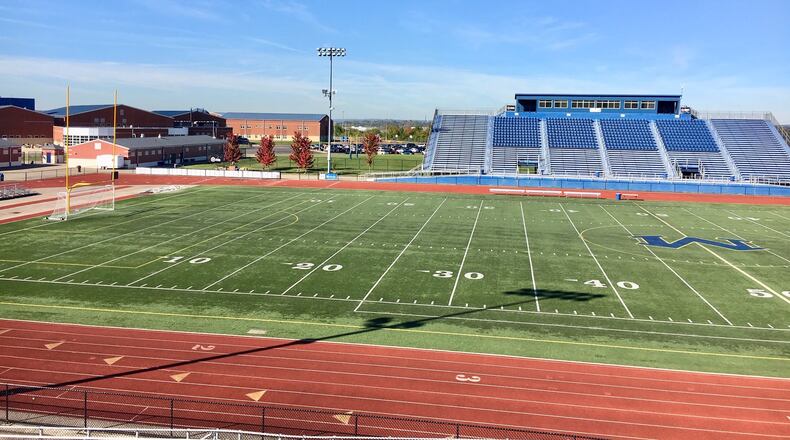Officials estimate the installation of a new turf surface would be around $360,000.
And the surrounding track also needs replacement, said school officials, with an estimated total cost of $250,000.
“The turf is several years beyond its life expectancy,” said Kathy Demers, superintendent of Monroe Schools.
Installed in 2005, the playing surface was transformational for the Butler County school system, allowing access to the main sports field that prior was strictly limited because of concerns of wear on the natural grass surface.
With a new, plastic grass field, for the first time in the schools’ history, the entire student body — whether it be through physical education classes, marching band, boys and girls outdoor sports — was able use the same field.
Moreover, local youth and adult sports leagues could also use the field, making it a true centerpiece of the Monroe community. And the field also allowed the district for the first time to host various state prep sports tournament games.
“The Monroe Schools turf field, track and stadium facilities have remained a real point of community pride and served the district well over the last 14 years,” said Demers.
“The football and soccer field and track have been used significantly not only by our schools and community members, but also many outside athletic groups and for (state) tournament events,” she said.
Monroe isn’t alone in Butler County facing thousands of dollars in artificial field replacement costs.
Lakota Schools’ two high schools — Lakota West and Lakota East — both saw plastic turf fields installed in 2009 and are nearing their projected expiration dates.
Hamilton Schools last year replace their first generation field for $400,000 and in recent years Mason and Kings school districts in southern Warren County have installed second-generation fields.
MORE: Hamilton Schools replace 1st generation artificial turf field
Field manufacturers offer projections for field life ranging from 10 to 12 years, depending on a number of variables including weather and frequency of usage.
In the early 2000s the artificial turf fields, which range in cost from $1 million to $2 million, revolutionized prep sports locally and nationally by offering for the first time an alternative to the expensive, fragile and weather-dependent grass sports fields. A single rainy, muddy game would deteriorate a field, leaving it largely unusable for the rest of the season as time and maintenance were needed to restore the grassy surface.
Replacing an artificial field surface is less expensive than the original installation cost because the underlying support and drainage systems are already in place.
The surrounding track also needs replacement, said Monroe Schools Athletic Director Eric Silverman during an August school board presentation where he presented a combined, estimated total for replacing both the field and track at about $610,000.
Silverman said patch work repairs to date have maintained the track and may also help prolong the turf surface.
Among Butler County’s 10 school districts, seven have artificial turf fields with Ross, New Miami and Madison still playing sports on natural grass fields.
About the Author
